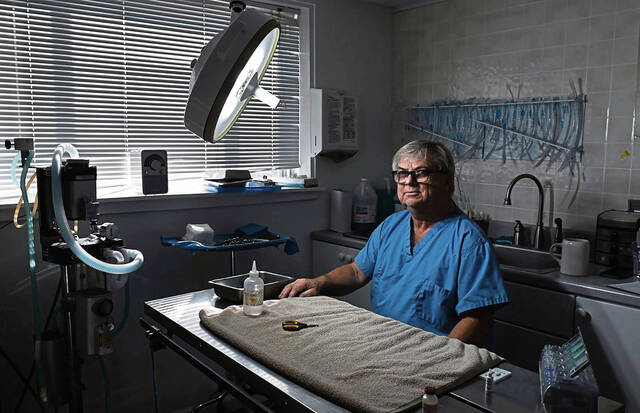https://triblive.com/local/westmoreland/its-the-most-moving-thing-living-donors-provide-organs-to-keep-others-alive/
'The most moving thing': Living donors provide organs to keep others alive

It’s not like asking your friendly neighbor for a cup of sugar.
It’s asking someone — be it a relative, friend or even a stranger — to become a living donor. To give up a part of their body to possibly save your life.
The scenario may seem surreal, but it’s increasingly common, and exactly what health system living donor programs encourage.
It can be nerve wracking for a transplant patient who already is facing uncertainty to seek help outside their normal circle of friends and family.
Pleas can be shared on social media or in front of much larger audiences, via vehicle windows, at sporting events or on billboards, anything to increase the probability of finding the right person at the right time.
“They want you to put it out there,” said Kathy Midgley, 67, of Delmont, who is looking for a living kidney donor. “That’s hard. I’m a private person, but my friends and family know.”
There are more people in our communities than we realize who are looking for living organ donors, according to Dr. Amit Tevar, surgical director of UPMC’s kidney transplant program. He performs those surgeries regularly, putting a compassionate donor’s kidney into the body of someone who desperately needs one.
“Every time you see it, it’s the most moving thing,” he said.
At least three Westmoreland County residents are hoping to find the right match.
Midgley, a retired Franklin Regional art teacher, and Greensburg veterinarian Wojciech Sliwa, 72, of Harrison City, are looking for living kidney donors. Mt. Pleasant Borough Manager Jeff Landy, 64, needs a living donor to share a piece of their liver.
The trio are among thousands of people across the country who at any time are looking for living organ donors, which is a preferable method for donation of certain organs rather than one from a cadaver. Tevar and Janice Glidewell, director of transplant operations at Allegheny Health Network, said studies show an increased survival rate in transplants involving living donors. Plus, it can reduce time on a waiting list.
“If we had our way, everyone would get a living donor,” Tevar said.
UPMC and AHN surgeons perform living donor transplants for liver and kidney recipients. UPMC has performed more than 400 each living kidney and liver donor transplants since 2017, statistics provided by the health system show. AHN started its living liver donor transplant program in June 2021 and performed two such surgeries that year, according to data from the Scientific Registry of Transplant Recipients. Surgeons at the health system have done 129 living kidney donor transplants between 2017 and 2021.
Nationwide, about 23% of kidney transplants in 2021 involved living donors, more than half of whom were not related to the recipient, according to the Scientific Registry of Transplant Recipients. One kidney can replace two nonfunctioning kidneys. About 6% of liver transplants across the country in 2019 were from living donors, registry statistics show. A portion of a healthy person’s liver, an organ that can regrow, is transplanted to replace a failing liver.
The transplant patient’s medical insurance covers the costs of both surgeries.
Landy’s daughter put together a video to get the word out, and announcements were made at the Mt. Pleasant Glass Festival, which Landy co-founded. He was diagnosed with liver cancer earlier this year after a colonoscopy and also learned he has cirrhosis of the liver not related to alcohol use during an MRI/CT scan.
“I think about it every day, but if I stay busy and stay hopeful and stay positive then I get through, ” he said.
Midgley has adopted the same attitude. Her husband, Steve, who works in the information systems department of the Tribune-Review, recently mentioned her plight in an internal employee newsletter. She turns to art and her old English sheepdog, Puddles, for comfort.
“It’s terrifying,” she said. “There’s no stability. You can’t always tell when things are going badly.”
She and Sliwa, a native of Poland who has kidney damage from Type 2 diabetes, have so far managed to avoid being put on dialysis. Finding willing donors will help them eliminate that possibility altogether.
“It’s not easy to find it,” said Sliwa, who has been at All Pets Hospital since 1997 and previously practiced in North Huntingdon.
He, like and Landy and Midgley, has found ways to cope while remaining strong.
“I’m dealing with this pretty well. I’m not depressed; I’m not stressed,” Sliwa said.
Prospective donors go through rigorous testing to determine whether they are good candidates. For AHN patients, that starts with a review of past medical and surgical history followed up with an in-person evaluation, Glidewell said.
It’s a similar process with UPMC, Tevar said. Doctors have to make sure donors are healthy and will be able to return to a normal life. When it does happen, it’s amazing, he said.
“Just truly the most selfless, altruistic, wonderful people that you’ve met,” he said.
Midgley, Sliwa and Landy are UPMC patients. To apply to help one of them, visit livingdonorreg.upmc.com and add in the recipient’s name after selecting “donation to specific individual.”
To register as a living donor through AHN, contact 412-359-4579 or visit agh.donorscreen.org/register/now.
Copyright ©2025— Trib Total Media, LLC (TribLIVE.com)
